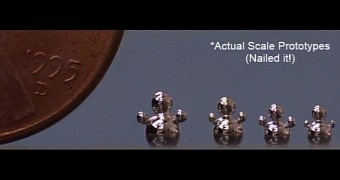A paper set to be published in this week's issue of the journal Proceedings of the National Academy of Science details the use of low voltages to control liquid metal and get it to take various shapes.
Under any other circumstances, this piece of news would spell boredom to anyone who is not head over heels in love with science and technology. Thus, there's one very important detail that makes this research project appealing to regular folks.
Long story short, this liquid metal manipulation via low voltages made it possible for scientists to create scale models of T-1000, the shapeshifting robot assassin featured in “Terminator 2: Judgement Day.”
Truth be told, these scale models, pictured next to this article, look less like the vicious T-1000 automaton and more like snowmen. Still, the fact that scientists have managed to create them counts as one step forward towards bringing the robot assassin to life.
What's more, there is little doubt that, even if T-1000 is to forever remain a work of fiction, these experiments pave the way to the development of a new generation of reconfigurable electronic circuits, antennas, and the like.
Using low voltages to manipulate liquid metal
In their paper detailing this series of experiments, the North Carolina State University specialists behind this research project detail that the liquid metal that they got to toy with was an alloy of gallium and indium.
The scientists explain that, when in its usual state, this alloy has a surface tension of roughly 500 millinewtons (mN)/meter. Consequently, it takes the shape of a spherical blob, EurekAlert informs.
When the alloy is exposed to low voltages, its surface tension drops to a considerable extent. As a result, the gallium and indium mixture loses its spherical blob shape under the influence of the gravitational pull acting on it.
“We discovered that applying a small, positive charge – less than 1 volt – causes an electrochemical reaction that creates an oxide layer on the surface of the metal, dramatically lowering the surface tension from 500 mN/meter to around 2 mN/meter,” says Dr. Michael Dickey.
“This change allows the liquid metal to spread out like a pancake, due to gravity. The resulting changes in surface tension are among the largest ever reported, which is remarkable considering it can be manipulated by less than one volt,” the researcher goes on to explain.
Potential uses for this technology
Using low voltages to manipulate liquid metal and get it to take various shapes might sound like something one would do just to pass the time and have some fun, but by the looks of it, there is more to these experiments than creating scale models of the “Terminator 2” automaton.
Thus, the North Carolina State University specialists expect their work will help pave the way to the development of new and improved circuits, antennas, and all sorts of devices. What's more, the researchers suspect that it might be possible to use this technology to manipulate several other materials.
“We can use this technique to control the movement of liquid metals, allowing us to change the shape of antennas and complete or break circuits,” argues Dr. Michael Dickey. Furthermore, “It could also be used in microfluidic channels, MEMS, or photonic and optical devices. Many materials form surface oxides, so the work could extend beyond the liquid metals studied here.”
If you have about 3 minutes to spare, be sure to check out the video below to see for yourself how the gallium and indium alloy behaves when exposed to low voltages.

 14 DAY TRIAL //
14 DAY TRIAL // 